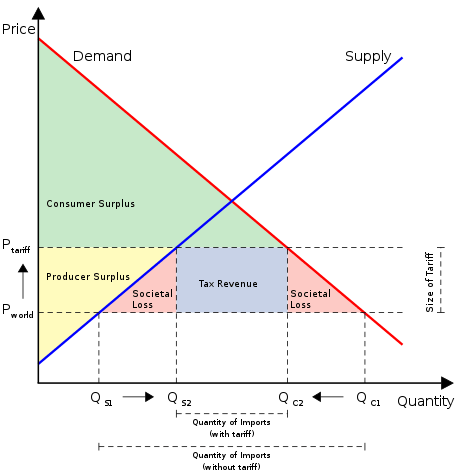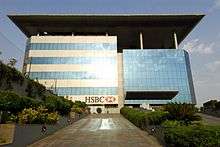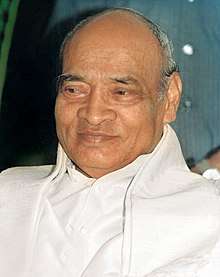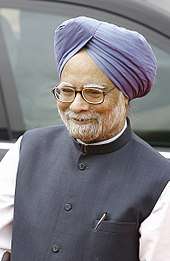Economic liberalisation in India
The economic liberalisation in India refers to the economic liberalisation of the country's economic policies, initiated in 1991 with the goal of making the economy more market- and service-oriented, and expanding the role of private and foreign investment.[1] Most of these changes were made as part of the conditions laid out by the World Bank and the IMF as a condition for a $500 million bail out to the Indian government in December 1991.[2] Specific changes include a reduction in import tariffs, deregulation of markets, reduction of taxes, and greater foreign investment. Liberalisation has been credited by its proponents for the high economic growth recorded by the country in the 1990s and 2000s. Its opponents have blamed it for increased inequality and economic degradation. The overall direction of liberalisation has since remained the same, irrespective of the ruling party, although no party has yet solved a variety of politically difficult issues, such as liberalising labour laws and reducing agricultural subsidies.[3] There exists a lively debate in India as to whether the economic reforms were sustainable and beneficial to the people of India as a whole.[4][5]
| Part of the Politics series on |
| Economic liberalism |
|---|
 |
|
Origins |
|
Ideas
|
|
Theories
|
|
Economics
|
|
Movements
|
|
Governance
|
|
People
|
|
Related topics
|
|
Indian government coalitions have been advised by the IMF and World Bank to continue liberalisation. Before 2015, India grew at a slower pace than China, which had been liberalising its economy since 1978.[6] In 2015, India's GDP growth outpaced that of China.[7] The McKinsey Quarterly stated that "removing major obstacles would free India's economy to grow as fast as China's, at 10% a year".[8]
There has been significant debate, however, around liberalisation as an inclusive economic growth strategy. Income inequality has deepened in India since 1992, with consumption among the poorest staying stable while the wealthiest generate consumption growth.[9] India's gross domestic product (GDP) growth rate in 2012–13 was the lowest for a decade, at just 5.1%,[10] at which time more criticism of India's economic reforms surfaced; it apparently failed to address employment growth, nutritional values in terms of food intake in calories, and also export growth—and thereby was leading to a worsening current account deficit compared to the period prior to reform.[11]
Pre-liberalisation policies
Indian economic policy after independence was influenced by the colonial experience (which was seen by Indian leaders as exploitative in nature) and by those leaders' exposure to Fabian socialism. Policy tended towards protectionism, with a strong emphasis on import substitution industrialization under state monitoring, state intervention at the micro level in all businesses especially in labour and financial markets, a large public sector, business regulation, and central planning.[12] Five-Year Plans of India resembled central planning in the Soviet Union. Steel, mining, machine tools, water, telecommunications, insurance, and electrical plants, among other industries, were effectively nationalised in the mid-1950s.[13] Elaborate licences, regulations and the accompanying red tape, commonly referred to as Licence Raj, were required to set up business in India between 1947-90.[14]
Before the process of reform began in 1991, the government attempted to close the Indian economy to the outside world. The Indian currency, the rupee, was inconvertible and high tariffs and import licensing prevented foreign goods reaching the market.[15] India also operated a system of central planning for the economy, in which firms required licences to invest and develop. The labyrinthine bureaucracy often led to absurd restrictions—up to 80 agencies had to be satisfied before a firm could be granted a licence to produce and the state would decide what was produced, how much, at what price and what sources of capital were used. The government also prevented firms from laying off workers or closing factories. The central pillar of the policy was import substitution, the belief that India needed to rely on internal markets for development, not international trade—a belief generated by a mixture of socialism and the experience of colonial exploitation. Planning and the state, rather than markets, would determine how much investment was needed in which sectors.
Pre-1991 liberalisation attempt
Attempts were made to liberalise the economy in 1966 and 1985. The first attempt was reversed in 1967. Thereafter, a stronger version of socialism was adopted. The second major attempt was in 1985 by Prime Minister Rajiv Gandhi. The process came to a halt in 1987, though no reversal of the policy took place unlike previously.[4]
In the 1980s, the government led by Rajiv Gandhi started light reforms. The government slightly reduced Licence Raj and also promoted the growth of the telecommunications and software industries.[17]
The Chandra Shekhar Singh government (1990–91) took several significant steps towards the much needed reforms and laid its foundation.[18]
Prevailing situation during 1980s
- The low annual growth rate of the economy of India before 1980, which stagnated around 3.5% from the 1950s to 1980s, while per capita income averaged 1.3%.[19] At the same time, Pakistan grew by 5%, Indonesia by 9%, Thailand by 9%, South Korea by 10% and Taiwan by 12%.[20]
- Only four or five licences would be given for steel, electrical power and communications. Licence owners built up huge powerful empires.[16]
- A huge private sector emerged. State-owned enterprises made large losses.[16]
- Income Tax Department and Customs Department became inefficient in checking tax evasion.
- Infrastructure investment was poor because of the public sector monopoly.[16]
- Licence Raj established the "irresponsible, self-perpetuating bureaucracy that still exists throughout much of the country"[21] and corruption flourished under this system.[22]
First reforms (1991–96)
Crisis that led to the Economic liberalisation
By 1991, India still had a fixed exchange rate system, where the rupee was pegged to the value of a basket of currencies of major trading partners. India started having balance of payments problems since 1985, and by the end of 1990, the state of India was in a serious economic crisis. The government was close to default,[26][27] its central bank had refused new credit and foreign exchange reserves had reduced to the point that India could barely finance three weeks’ worth of imports. It had to pledge 20 tonnes of gold to Union Bank of Switzerland and 47 tonnes to Bank of England as part of a bailout deal with the International Monetary Fund (IMF). Most of the economic reforms were forced upon India as a part of the IMF bailout.[28]
A Balance of Payments crisis in 1991 pushed the country to near bankruptcy. In return for an IMF bailout, gold was transferred to London as collateral, the rupee devalued and economic reforms were forced upon India. That low point was the catalyst required to transform the economy through badly needed reforms to unshackle the economy. Controls started to be dismantled, tariffs, duties, and taxes progressively lowered, state monopolies broken, the economy was opened to trade and investment, private sector enterprise and competition were encouraged and globalisation was slowly embraced. The reforms process continues today and is accepted by all political parties, but the speed is often held hostage by coalition politics and vested interests.
— India Report, Astaire Research[22]
Liberalisation of 1991 and World Bank loan
In response to the above-mentioned crisis, the Finance ministry led by, the finance minister Manmohan Singh, initiated the economic liberalisation of 1991 with the support of the then Prime minister Narasimha Rao. The reforms did away with the Licence Raj, reduced tariffs and interest rates and ended many public monopolies, allowing automatic approval of foreign direct investment in many sectors.[29] Since then, the overall thrust of liberalisation has remained the same, although no government has tried to take on powerful lobbies such as trade unions and farmers, on contentious issues such as reforming labour laws and reducing agricultural subsidies.[30] By the turn of the 21st century, India had progressed towards a free-market economy, with a substantial reduction in state control of the economy and increased financial liberalisation.[31] This has been accompanied by increases in life expectancy, literacy rates, and food security, although urban residents have benefited more than rural residents.[32] World Bank loans had been taken for agricultural projects since 1972, these continued as international seed companies were able to enter Indian markets.[33]
On 12 November 1991, based on an application from the Government of India, World Bank sanctioned a structural adjustment loan / credit that consisted of two components - an IBRD loan of $250 million to be paid over 20 years, and an IDA credit of SDR 183.8 million (equivalent to $250 million) with 35 years maturity, through India's ministry of finance, with the President of India as the borrower. The loan was meant primarily to support the government's program of stabilization and economic reform. This specified deregulation, increased foreign direct investment, liberalization of the trade regime, reforming domestic interest rates, strengthening capital markets (stock exchanges), and initiating public enterprise reform (selling off public enterprises).[34]
Later reforms
- The Bharatiya Janata Party (BJP)–Atal Bihari Vajpayee administration surprised many by continuing reforms, when it was at the helm of affairs of India for six years, from 1998–99 and from 1999–2004.[35]
- The BJP-led National Democratic Alliance Coalition began privatising under-performing government-owned business including hotels, VSNL, Maruti Suzuki, and airports, and began reduction of taxes, an overall fiscal policy aimed at reducing deficits and debts and increased initiatives for public works.
- The United Front government attempted a progressive budget that encouraged reforms, but the 1997 Asian financial crisis and political instability created economic stagnation.
- Towards the end of 2011, the Congress-led UPA-2 Coalition Government initiated the introduction of 51% Foreign Direct Investment in retail sector. But due to pressure from fellow coalition parties and the opposition, the decision was rolled back. However, it was approved in December 2012.[36]
- In the early months of 2015, the second BJP-led NDA Government under Narendra Modi further opened up the insurance sector by allowing up to 49% FDI. This came seven years after the previous government attempted and failed to push through the same reforms and 16 years after the sector was first opened to foreign investors up to 26% under the first BJP-led NDA Government under Atal Bihari Vajpayee's administration.[37]
- The second BJP-led NDA Government also opened up the coal industry through the passing of the Coal Mines (Special Provisions) Bill of 2015. It effectively ended the Indian central government's monopoly over the mining of coal, which existed since nationalization in 1973 through socialist controls. It has opened up the path for private, foreign investments in the sector, since Indian arms of foreign companies are entitled to bid for coal blocks and licences, as well as for commercial mining of coal. This could result in billions of dollars investments by domestic and foreign miners. The move is also beneficial to the state-owned Coal India Limited, which may now get the elbow room to bring in some much needed technology and best practices, while opening up prospects of a better future for millions of mine workers.[38]
- In the 2016 budget session of Parliament, the Narendra Modi led BJP Government pushed through the Insolvency and Bankruptcy Code. The Code creates time-bound processes for insolvency resolution of companies and individuals. These processes will be completed within 180 days. If insolvency cannot be resolved, the assets of the borrowers may be sold to repay creditors. This law drastically eases the process of doing business, according to experts and is considered by many to be the second most important reform in India since 1991 next to the proposed GST.[39]
- On July 1, 2017, the BJP-led NDA Government under Narendra Modi approved the Act to Uniform Goods and Services Tax (India). It was approved 17 years after the legislation was first proposed under the earlier BJP-led NDA Government under Atal Bihari Vajpayee's administration in 2000.[40] Touted to be India's biggest tax reform in 70 years of independence and the most important overall reform in terms of ease of doing business since 1991. GST replaced a slew of indirect taxes with a unified tax structure and was therefore showcased as dramatically reshaping the country's 2.5 trillion dollar economy.[41]
- In the NDA-2 government, Finance Minister Nirmala Sitharaman had on September 20, 2019 announced lowering of the base corporate tax rate to 22 per cent from 30 per cent for companies that do not seek exemptions, and reduced the rate for new manufacturing companies to 15 per cent from 25 per cent. It is believed that this would be very beneficial in attracting investment by MNCs in the Indian economy and thus help in its growth.
Impact

The economic liberalization of India had a multitude of impacts, some of which were positive and others negative for its people . The foreign investment in the country (including foreign direct investment, portfolio investment, and investment raised on international capital markets) increased from a minuscule US$132 million in 1991–92 to $5.3 billion in 1995–96.[42] On the other hand, it also enabled a number of companies like Enron to invest more easily in India, in over expensive projects.[43] As per the US Senate, the largest share of foreign direct investment in India since 1992 came from Enron (more than 10%).[44]
However, institutions like the OECD applauded it:
Its annual growth in GDP per capita accelerated from just 1¼ per cent in the three decades after Independence to 7½ per cent currently, a rate of growth that will double average income in a decade.... In service sectors where government regulation has been eased significantly or is less burdensome—such as communications, insurance, asset management and information technology—output has grown rapidly, with exports of information technology enabled services particularly strong. In those infrastructure sectors which have been opened to competition, such as telecoms and civil aviation, the private sector has proven to be extremely effective and growth has been phenomenal.
The election of AB Vajpayee as Prime Minister of India in 1998 and his agenda was seen as a welcome change by some. His prescription to speed up economic progress included possible solutions of the outstanding Cold War related problems with the West and further opening up FDI. In three years, the West was developing a bit of a fascination to India's brainpower, powered by IT and BPO. By 2004, the West would consider investment in India, should the conditions permit. By the end of Vajpayee's term as prime minister, a framework for the foreign investment had been established. The new incoming government of Dr. Manmohan Singh in 2004 further strengthened the required infrastructure to welcome the FDI.
The fruits of liberalisation reached their peak in 2006, when India recorded its highest GDP growth rate of 9.6%.[46] With this, India became the second fastest growing major economy in the world, next only to China.[47] The growth rate has slowed significantly in the first half of 2012.[48] An Organisation for Economic Co-operation and Development (OECD) report states that the average growth rate 7.5% will double the average income in a decade, and more reforms would speed up the pace.[45] The economy then rebounded to 7.3% growth in 2014–15.
See also
- Economy of India
- Globalisation in India
- Licence Raj
- Hindu rate of growth
- Economic miracle
References
- Bank, The World (12 November 1991). "India - Structural Adjustment Credit Project (English) - Presidents report". www.documents.worldbank.org. World bank: 1. Retrieved 30 October 2018.
- "Structural adjustments in India - a reportof the Independent Evaluation Group (IEG)". www.lnweb90.worldbank.org. World bank. Archived from the original on 9 May 2019. Retrieved 30 October 2018.
- "That old Gandhi magic". The Economist. 27 November 1997.
- Sharma, Chanchal Kumar (2011). "A Discursive Dominance Theory of Economic Reform Sustainability: The Case of India". India Review. 10 (2): 126–184. CiteSeerX 10.1.1.627.2831. doi:10.1080/14736489.2011.574550.
- Bank, The World (12 November 1991). "Project proposal - Structured adjustment of India". www.documents.worldbank.org. World Bank: 1. Retrieved 30 October 2018.
- "India's economy: What's holding India back?". The Economist. 6 March 2008.
- "India outpaces China in 2015 economic growth". BBC News. 8 February 2016.
- "The McKinsey Quarterly: India – From emerging to surging" (PDF). The McKinsey Quarterly. 2001.
- "India's income inequality has doubled in 20 years". Timesofindia.indiatimes.com. The Times of India. Retrieved 10 July 2013.
- GDP growth slumps to 5%, a decade’s low, Hindu Business Line 31 May 2013
- India’s Ponzi-styled economic reforms run out of steam, East Asia Forum 4 June 2013
- Kelegama, Saman; Parikh, Kirit (2000). "Political Economy of Growth and Reforms in South Asia". Second Draft. Archived from the original on 11 February 2006. Cite journal requires
|journal=(help) - Sam Staley (2006). "The Rise and Fall of Indian Socialism: Why India embraced economic reform". Archived from the original on 14 January 2009. Retrieved 10 January 2009.
- Street Hawking Promise Jobs in Future Archived 29 March 2008 at the Wayback Machine, The Times of India, 25 November 2001
- "India: 1991 country economic memorandum" (PDF). www.documents.worldbank.org. World bank. Retrieved 30 October 2018.
- "India: the economy". BBC. 12 February 1998.
- History of Computing in India: 1955–2010, Rajaraman, V.
- "New Indian Express". New Indian Express. Retrieved 18 January 2016.
- "Redefining The Hindu Rate of Growth". The Financial Express. 12 April 2004.
- "Industry passing through phase of transition". The Tribune India.
- Eugene M. Makar (2007). An American's Guide to Doing Business in India.
- "The India Report" (PDF). Astaire Research. Archived from the original (PDF) on 14 January 2009.
- "Narasimha Rao – a Reforming PM". news.bbc.co.uk. BBC News. 23 December 2004. Retrieved 2 March 2007.
- V. Venkatesan (1–14 January 2005). "Obituary: A scholar and a politician". Frontline. 22 (1). Archived from the original on 30 January 2010. Retrieved 30 March 2010.
- PV Narasimha Rao Passes Away. Retrieved 7 October 2007. Archived 1 November 2007 at the Wayback Machine
- India's Pathway through Financial Crisis Archived 12 November 2011 at the Wayback Machine. Arunabha Ghosh. Global Economic Governance Programme. Retrieved on 2 March 2007.
- What Caused the 1991 Currency Crisis in India? Archived 2 September 2013 at the Wayback Machine, IMF Staff Papers, Valerie Cerra and Sweta Chaman Saxena.
- Economic Crisis Forcing Once Self-Reliant India to Seek Aid, New York Times, 29 June 1991
- Task Force Report 2006, pp. 7–8.
- "That old Gandhi magic". The Economist. 27 November 1997. Retrieved 17 January 2011.
- Kumar 2005, p. 1037
- Task Force Report 2006, pp. 17–20.
- Sainath, P. Everybody loves a good drought. Sage Publications.
- "World bank report P-5678-IN - report of the IBRD and IDA on a proposed structural adjustment loan to India" (PDF). www.documents.worldbank.org. World bank official website. Retrieved 30 October 2018.
- J. Bradford DeLong (2001). "India Since Independence: An Analytic Growth Narrative" (PDF).
- "End of policy paralysis: Govt approves 51% FDI in multi-brand retail". Zeenews.india.com. 14 September 2012. Retrieved 10 July 2013.
- "Parliament passes insurance bill in a major boost to Modi's reforms agenda". livemint.com. 12 March 2015. Retrieved 13 March 2015.
- "Parliament boost to Modi's plans: Coal, mining bills passed by Rajya Sabha". indiatoday.intotoday.in. Retrieved 29 March 2015.
- "Bankruptcy code biggest economic reform after GST: Finance Ministry". Retrieved 11 May 2016.
- "F. .No. CBEC-20/05/01/2018-GST Government of India …" (PDF). www.cbic.gov.in/. Ministry of Finance, Government of India. Archived from the original (PDF) on 26 August 2018.
- "GST Launch Time Midnight Parliament Session". Hindustantimes.com. 30 June 2017. Retrieved 20 July 2017.
- Local industrialists against multinationals. Ajay Singh and Arjuna Ranawana. Asiaweek. Retrieved on 2 March 2007.
- Roy, Sandip (7 February 2002). "Enron in India - The giant's first fall" (March 2002). Outlook. Pacific news Service. Retrieved 25 October 2016.
- "118High-Stakes Showdown; Enron's Fight Over Power Plant Reverberates Beyond India" (PDF). New York Times. 20 March 2001. Archived from the original (PDF) on 25 October 2016. Retrieved 26 November 2018.
- "Economic survey of India 2007: Policy Brief" (PDF). OECD. Archived from the original (PDF) on 6 June 2011.
- "The World Factbook". Cia.gov. Retrieved 10 July 2013.
- "The India Report" (PDF). Astaire Research. Archived from the original (PDF) on 14 January 2009.
- "India growth rate slows to 5.3% in first quarter". BBC.co.uk. 31 May 2012. Retrieved 10 July 2013.
External links
- For a short educational video of the "economic history of India".
- Nick Gillespie (2009). "What Slumdog Millionaire can teach Americans about economic stimulus". Reason. Archived from the original on 13 June 2009. Retrieved 6 April 2009.
- Gurcharan Das (2006). "The India Model". The Foreign Affairs. Archived from the original on 7 March 2009.
- Ravinder Kaur (2015). "Good Times, Brought to you by Brand Modi". Television and New Media.
- Ravinder Kaur (2012). "India Inc. and its Moral Discontent". Economic and Political Weekly.
- Aditya Gupta (2006). "How wrong has the Indian Left been about economic reforms?" (PDF). Centre for Civil Society. Archived from the original (PDF) on 26 February 2009. Retrieved 25 February 2009.
- "The India Report" (PDF). Astaire Research <<doesn't work>>. 2007. Archived from the original (PDF) on 14 January 2009.

